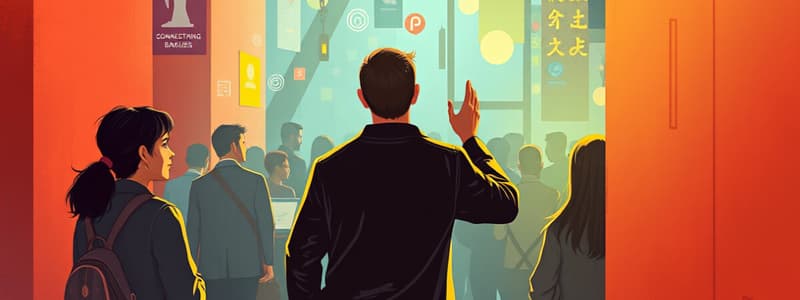Podcast
Questions and Answers
What is the primary purpose of David Berlo's communication model?
What is the primary purpose of David Berlo's communication model?
- To analyze cultural communication
- To develop effective communication between sender and receiver (correct)
- To enhance technological functionality
- To create graphic design elements
David Berlo’s model was initially created specifically for general communication purposes.
David Berlo’s model was initially created specifically for general communication purposes.
False (B)
What term does David Berlo’s model use to describe factors that affect the communication process?
What term does David Berlo’s model use to describe factors that affect the communication process?
Noise
In the Osgood–Schramm model, communication skills refer to an individual’s skill to communicate, including the ability to read, write, speak, and _____.
In the Osgood–Schramm model, communication skills refer to an individual’s skill to communicate, including the ability to read, write, speak, and _____.
Match the following models with their key features:
Match the following models with their key features:
What is not a form of oral communication?
What is not a form of oral communication?
Written communication includes forms like books and newspapers.
Written communication includes forms like books and newspapers.
What are some examples of spoken communication?
What are some examples of spoken communication?
_____ communication is conveyed through written signs or words.
_____ communication is conveyed through written signs or words.
Match the following communication types with their definitions:
Match the following communication types with their definitions:
Flashcards are hidden until you start studying
Study Notes
Communication Processes
- Noise refers to disruptions in communication, affecting the exchange of messages.
- Communication occurs through spoken words, public speeches, news broadcasts, and conversations.
- Written communication includes handwritten documents, newspapers, letters, and books.
Communication Models
- Lasswell’s model aims to enhance effective communication between sender and receiver while identifying influencing factors termed as "Noise".
- David Berlo's model focuses on elements like communication skills, knowledge, attitudes, and social systems, indicating the circular nature of communication.
- Osgood–Schramm model emphasizes a circular communication process involving encoding and decoding of messages with the sender as the encoder and the receiver as the decoder.
- Westley and MacLean's model provides a broader perspective on communication dynamics, including feedback loops.
Reception Theory
- Stuart Hall's Encoding/Decoding model differentiates between understanding media messages and the importance of media and information literacy.
- Media literacy relates to the comprehension and production of messages, whereas information literacy encompasses the acquisition and utilization of information effectively.
Technology Literacy
- Defined by Bautista et al. as the ability to use technology to solve problems and improve learning outcomes in various subjects.
- Emphasizes responsible use of tools and networks for accessing, evaluating, and generating information.
Information Literacy
Components of Information Literacy
- Finding: Effectively locate necessary information using various strategies, such as Boolean searches and library catalog systems.
- Acknowledging: Recognize and cite sources ethically, understanding legal and social issues surrounding information.
Academic and Real-world Examples
- Academic: Citing sources in research papers, creating bibliographies, understanding plagiarism laws.
- Real-world: Attributing reposted images, requesting genealogical records, and following copyright regulations.
Typology of Information
- Focuses on classifying the types of information and understanding their implications for communication.
Studying That Suits You
Use AI to generate personalized quizzes and flashcards to suit your learning preferences.




